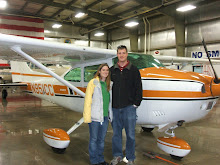"BUT??? Did the pilot have a FLIGHT PLAN??? Isn't that the standard statement whenever there's a (non-News media) accident or incident..."
This comment spawned a question whether flight following or a flight plan was better.
There were a lot of comments saying flight plans were a waste of time unless you would be flying in areas where you are out of communication with ATC. Some people also brought up the SPOT messenger from http://www.findmespot.com/en/.
Here are my responses to these posts that I thought were worth repeating.
I'm really surprised and I guess disappointed by the number of people who say they don't file flight plans? You have to get a brief (if nothing else to check TFRs and NOTAMS) so why not just file a flight plan at the same time. You need to make them work for you so you don't have to put every twist and turn in and if you know it'll take you 30 minutes to close after landing then just add it to your time enroute. It's better than not having anybody come after you.
BTW, it doesn't matter which one is better, what is stopping you from doing both? I file a flight plan when getting my brief, turn on my SPOT and clip my "close flight plan keychain" onto my airplane key during pre-flight, open my flight plan as soon as I leave the vicinity of the airport, then call up approach for flight following. When I'm securing the airplane and take the keys out of the ignition, I'm immediately reminded to close my flight plan by the keychain.
My issue with SPOT is if you were disabled during the wreck or if it launched out of the airplane during the wreck, then you wouldn't be able to hit the 911 button. In my case I'd be relying on people to realize I'm missing and then remember I told them how to track me down using my SPOT track.

--------------------------------------------------------------
I'm glad I read this message because it got me thinking after I wrote that last post... I was wondering if I can somehow connect my SPOT with the flight plan so that search and rescue would have access to my last known GPS location. I called SPOT and flight service to see what I could do.
First I called SPOT, my questions were related to if no 911 message was sent and the FAA or search and rescue called asking for the info, would they give it to them. The answer was NO unless they were one of my emergency contacts! I'm assuming that is unless you hit the 911 where they contact the emergency services. I asked if I could put "FAA" or "Emergency Services" as an emergency contact and he said yes. My primary emergency contact for my SPOT is now "Search and rescue and emergency services". I guess I do like the privacy considerations, but it seems stupid to let search and rescue have to search when they could be told where I am and to expedite the rescue.
I also called flight service and talked about the best way to get this information onto a flight plan. For VFR they said it was easy since the remarks field is free form type. He can put "Pilot has SPOT messenger on board" or "Contact family for last known GPS location". He said they only had 12 characters for IFR flight plans. I know some mountain search and rescue folks and they all know what the SPOT messenger is so I figure I can put "SPOT MSNGER" for 11 characters on the IFR flight plan and be good enough. I will be highly disappointed if they were to search for me and not google "SPOT MSNGER" if they didn't know what it was. BTW, the first hit on google for "SPOT MSNGER" is the company's website. I think this gives you the best of all worlds and is what I will be doing from now on.
Jayson



Maybe a true personal locator beacon is worth the money - no subscription, some have an impact sensor that sets off the beacon, and it automatically calls out the troops without the wait time.
ReplyDelete